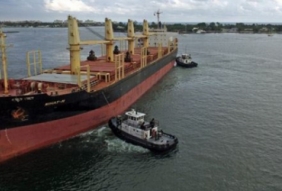
Posted on March 2, 2016
A $5.35 million maintenance dredging project at the Riviera Beach-based Port of Palm Beach’s entrance channel in the Lake Worth Inlet is expected to start early next week and continue through mid-April.
U.S. Army Corps of Engineers, Jacksonville District, spokeswoman Susan Jackson said approximately 200,000 cubic yards of shoal material will be removed from Palm Beach Harbor. The sand will be placed on the beach immediately south of the southern jetty at the north end of Palm Beach, extending it by 60 feet.
Great Lakes Dredge & Dock Co. of Oak Brook, Ill. has been hired by the Army Corps to perform the work at the harbor. The Lake Worth Inlet connects the harbor to the Atlantic Ocean. The job is 100 percent federally funded.
However, the port is paying Tallahassee-based WSource Group, a consulting firm, $7,500 to inspect the work and make sure the amount of sand specified in the contract is removed from the designated areas, including the entrance channel, Cut-1, Southern Turning Basin and Settling Basin
Port officials want the oversight because not enough sand was removed during a a dredging project conducted in November 2014. At that time the Army Corps hired Great Lakes to remove 1,200 to 1,400 cubic yards of sand, but the water was still too shallow in some places. Ships such as luxury yachts and freighters carrying steel rebar used in construction could not enter the port, and the port lost money, as ships went to other ports, the port’s executive director Manuel Almira said last year.
The port hired Weeks Marine, Cranford, N.J. to perform an emergency dredge that was completed in early January 2015. Another 3,200 cubic yards of sand was removed. The port split that $350,000 cost with the Florida Department of Transportation.
Army Corps project manager Shirsha Rayaprolou told the Port of Palm Beach Commission last week that the project that’s just beginning is a “major event,” and includes the entire harbor and basin. Dredging on this scale was last conducted in 2012, and the work should be sufficient to keep the waters at the proper depth for two years.
The contract calls for the entrance channel to be dredged to varying depths of 37 to 39 feet, the settling basin to 33 to 35 feet, and the southern turning basin to 33 feet deep.
The channel needs to be at least 33 feet deep in order for the ships to come in safely. Sand buildup, known as shoaling, occurs naturally and can make the channel too shallow in spots.
Using dredged materials on the shoreline helps to reduce risk and promotes coastal resilience. The additional beach area also has inherent benefits in restoring critical habitat for shorebirds and marine turtles.





